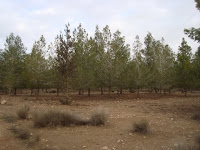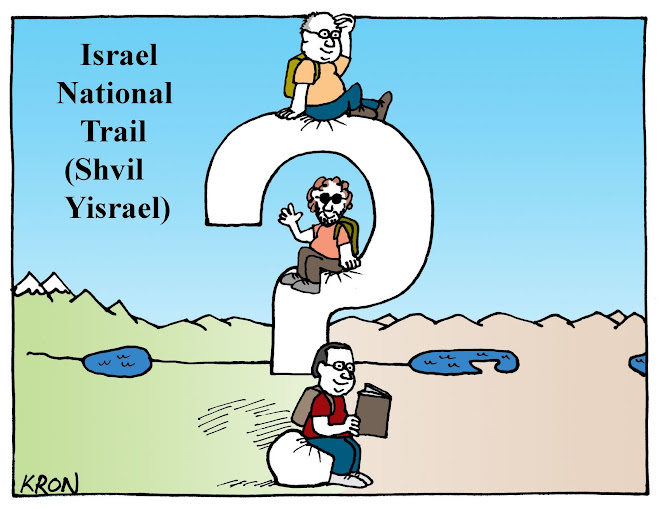Only 2 weeks after tackling Mt. Carmilla and the Burma Road Historical Picnic Table Route we were back on the trail, back to the Negev. Negev means another overnight.
We actually started a little later than what we would have liked. I had to stop off in Gadera along the way, wasting 30 precious pre shvil minutes, but that's another story. If you don't know where Gadera is, it's not on the shvil so you have no reason to look it up on Google maps. Believe me, you have no reason to look it up.
At 2.30 on a midwinter's day we got out of Yoni's car at Pura Nature Reserve, knowing that we didn't have a lot of time to get through the 12 km to my van before we ran out of light. Once again I had my trusty torch but I really didn't want to use it. We managed to finish just before 5 p.m. Sunset is about 5.30. If you take into account the obligatory stop for Garry's herbal tea and chocolate croissants, that's about a very quick 5 km per hour. We're in training for the Olympics.
Here and there I'd read a few things about the Pura nature reserve; about how pretty it is, about how there's a seasonal winter lake and about how it's an oasis in this semi-desert area. Must have been written by a blind man, or maybe I'm the blind man. Either way, I couldn't see any delineation between what was nature reserve and what wasn't, other than a few paths and wooden railings, put there apparently for the blind guy that said that it was something special. Still, it's better than grey industrial parks in Shoham.
Once we left the nature reserve it became quite pretty quite quickly. We were walking through rolling hills carpeted with bright green wheat fields. These wheat fields weren't large expanses of hundreds or thousands of dunams but parcels of green, obstructed by pieces of ground that couldn't be cultivated because they are constantly dropping and shifting. These are the Ruchama badlands. I always thought that badlands were areas occupied by lawless Cowboys or unruly Indians but apparently this isn't the case. Badlands are areas that are bad for agriculture because they are pocked with unstable, eroded and infertile patches. No matter. It made for a more interesting patchwork landscape.

If I'm already talking about badlands and those good old cowboys and Indians westerns, then the wild west imagery was enhanced by the broken down railway bride that we walked under. This bridge was part of the old Turkish (Ottoman) railway that went from Beirut to Cairo. There are not many remnants of it left here in Israel but here was a broken down brick structure that you might or might not recognise as an old train bridge. A tel here, a ruin there, it's just more evidence of another civilisation that has come and gone in this tiny, much-fought-over corner of the world that is the meeting place of Asia, Africa and Europe.

I don't remember the natural light being so obviously different last winter, when we were walking in the north. I know I've mentioned it these last few legs but once again the combination of weaker sun, cloud cover and late afternoon made the light soft, almost dull. The light and the time of day make for a totally different mindset. On one hand, getting up at 4.30 in the summer in order to drive a long way or to get on to the trail early enough to beat the heat puts you in a state of mind that almost makes the shvil like a workday, something to be negotiated. It gets hot quickly, the light is bright and glaring and you feel like your being tested. Yet when we start in the afternoon in the winter, everything is much gentler and more relaxed. The surroundings are green, the light subtle and subdued. You barely sweat. It may seem as if I clearly prefer the winter but this isn't the case. I like the heat and the challenge of a good hard day on the shvil but late afternoon walks are no less enjoyable. Just different. The vast majority of shvillers are young kids through walking, doing the entire route in one go over a two month period. I truly admire them. I've noticed, however, that one clear advantage of doing it as we do, a section at a time, a month at a time, is that we experience all the seasons and the natural cycle of the year. It adds another aspect to an already fascinating and multifaceted journey.
Back to the trail. We passed though the "gate" that used to be the railway bridge and followed the course of Nachal Shikma (sycamore). By the way, ex prime minister, general, etc Arik Sharon's ranch is called the Shikma Ranch and is located at the end of this creek, about 10 km away. Just as we were getting used to the landscape we came upon Tel Nagila (no relation to "hava nagila"). It was a short, steep climb to the top. The Tel is not that high, less than 100 metres above the surrounding countryside, but it was high enough to afford breathtaking 360° views. The tel on the surrounding landscape was something akin to an outy belly-button on a wavy stomach. The landmark was further emphasised by the very large acacia tree on top of the tel. This tel and its acacia tree are visible around the entire area. Over the next 8 km we would look around and always had the tree-topped belly button in view.




We continued walking alongside Nachal Shikma until the path abruptly turned right into Nachal Sed . This nachal is an anomaly for this area. Nachal Shikma is reasonably broad and shallow but Nachal Sed resembles a canyon, albeit not a very deep one. The walls are sheer and have papyrus reeds and even scattered date palms growing on the creek floor. The rocks that formed the small canyon were also very different from the surrounding area, but don't ask me to list what type of rock was here and what rock makes up the rest of this area, for I wouldn't have a clue. The path above the canyon that we were walking on was very close to the rim. It afforded us a good view of the canyon but a slip here would not have been much fun.



Speaking of slip, there was a fair bit of mud along the path as it had rained a lot during the previous days. Even today, the sky was overcast and the air was damp, but it never really threatened to rain. We were pretty sure that someone was going to slip at some point, Yoni being the bookies choice. Even he backed himself to be the first one to fall. The long shot was the winner. Garry is usually the most sure-footed but today was the first to get his knees dirty. Yoni did get the prize for the most spectacular, muddy fall and by luck I managed to stay relatively clean, or at least, on my feet.
We came out of Nachal Sed, wandered around the wet desert for a bit longer, passed a nice little eucalypt forest and then a pine forest and arrived back at my van at Tel Keshet at 5.00 p.m. Light was just beginning to fade. I almost needed my torch. Once again, we'd had a lovely afternoon stroll. A bit longer and a lot quicker than the previous afternoon stroll but very enjoyable, all the same.
I spend a lot of time criticizing Mr Shvil Painter and his bosses, the Shvil Elders, for their choices in determining the exact route the shvil takes. For once, I have a good word for them. It is only about 5 km along the busy route no. 40 between Pura nature reserve and Tel Keshet. Mr. Shvil Painter lay down a meandering 12 km route to cover the 5 km and it's easy to see why. The Ruchama badlands, the Turkish railway bridge, Tel Nagila and Nachal Sed would all be reason enough by themselves for a detour. All together in a small area, it would have been a crime to have missed them.


As is usually the case with our overnights, the walking may have finished but activities hadn't. The shvil goes right past kibbutz Lahav and the kibbutz has kindly set aside an old 2 room apartment for shvillers that come through. This was our abode for the night. Now I'm no snob, but I'm also not 21 years old anymore. We were all transported back 30 years when we all spent 6 months in a hovel on kibbutz as part of our post-school bridge year. The place was clean and tidy and well looked after BUT only had enough electricity for one electric appliance at a time. That is, only one heater can be on at any one time. The second room stays cold. If you want to use the kettle, both heaters go off. The hot water boiler for the shower? No kettle and no heaters. We learnt that we needn't go cold for the sake of the hot water boiler. It didn't work. No hot showers. At least there was running (cold) water. We were warned that if we didn't obey the electricity rules then the fuse would trip and the fuse box is in a locked room that we don't have access to. We took the warning seriously and still had electricity when we left the next morning.
We were joined at the apartment by two old friends visiting Israel from Australia. The Hochberg brothers, Danny and Joel stayed the night and walked the next day's leg with us. Danny was with us in Israel us on our machon year programme in 1978. Joel we know as Danny's younger brother. He'll be 80 and Danny will be 82 and he'll still be Danny's younger brother.
We'd heard of a restaurant called Little India and decided to give the lamb korma a try. I picked Sivan up from her shnat sherut with Kamea, her boyfriend who was visiting from his shnat sherut and met the others there. Yoni, who sometimes has a propensity to grumpiness, arrived at his grumpy worst. No hot water, conditions that took him back to the 70's and an empty stomach. Watch out world. It went from terrible to disastrous. Not only was there no lamb korma, there was no chicken tikka and no beef vindaloo. It was a fucking vegetarian restaurant. Garry had finally gotten his revenge for all those meals we've schlepped him to over the years, at steak houses, smoke-rooms and other assorted non-vegetarian adventures. The carnivores were not impressed. As it turned out, the food was quite good, we had some fish masala and lentil curry and left in far better spirits than when we arrived. I'll let you into a hush-hush secret, never to be revealed outside this blog….the carnivores actually enjoyed the vegetarian meal.
Back at the apartment, we were in bed by 10.30, prepared for an early start the next day. The Hochberg brothers didn't understand why my permanent shvil partners insisted on me sleeping in their room, but come morning they complained that common decency should dictate that they be warned about the Midnight Trumpet Concerto in B Flat. Guess they won't be joining me for a sleepover again in the foreseeable future.








































